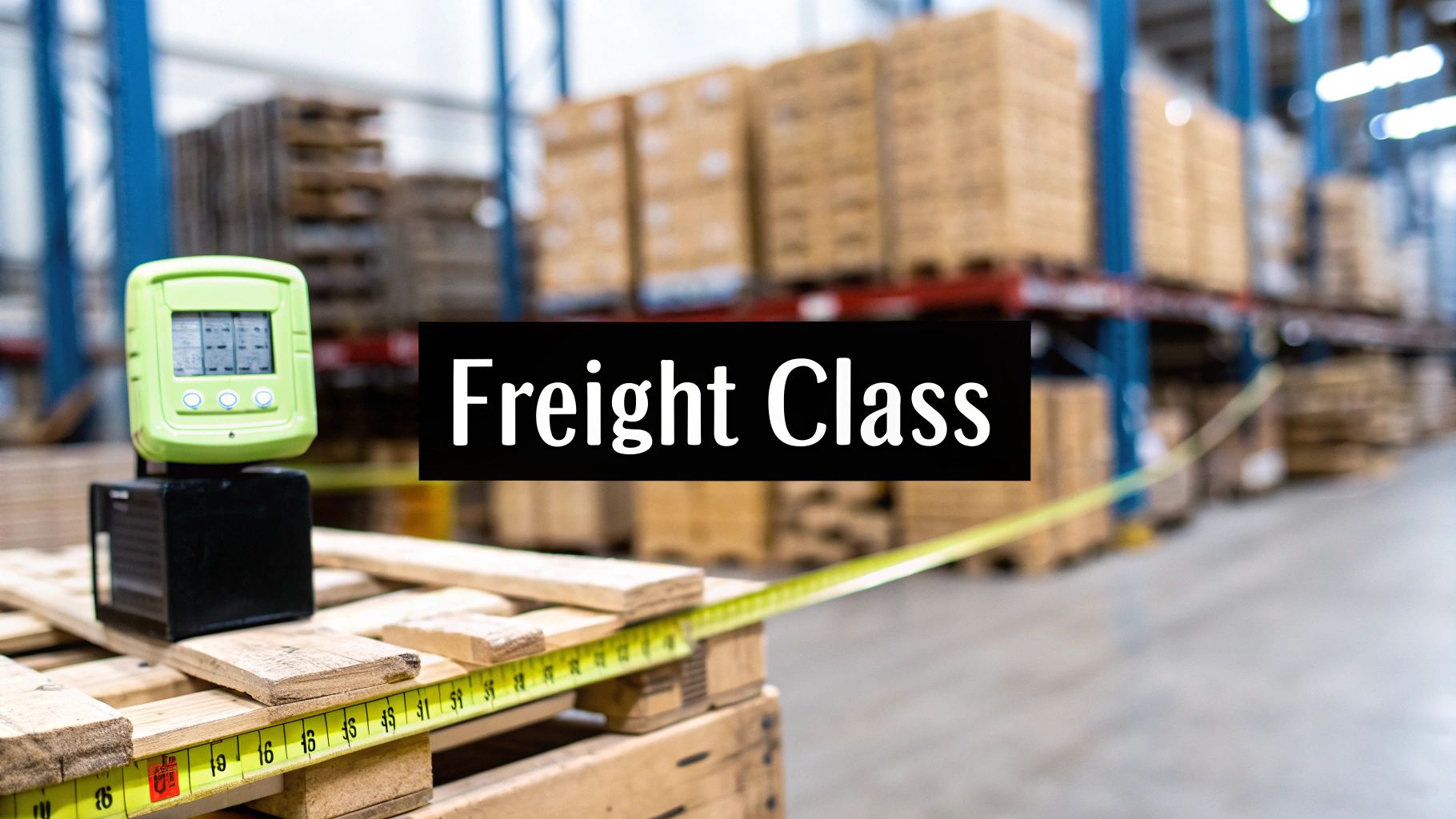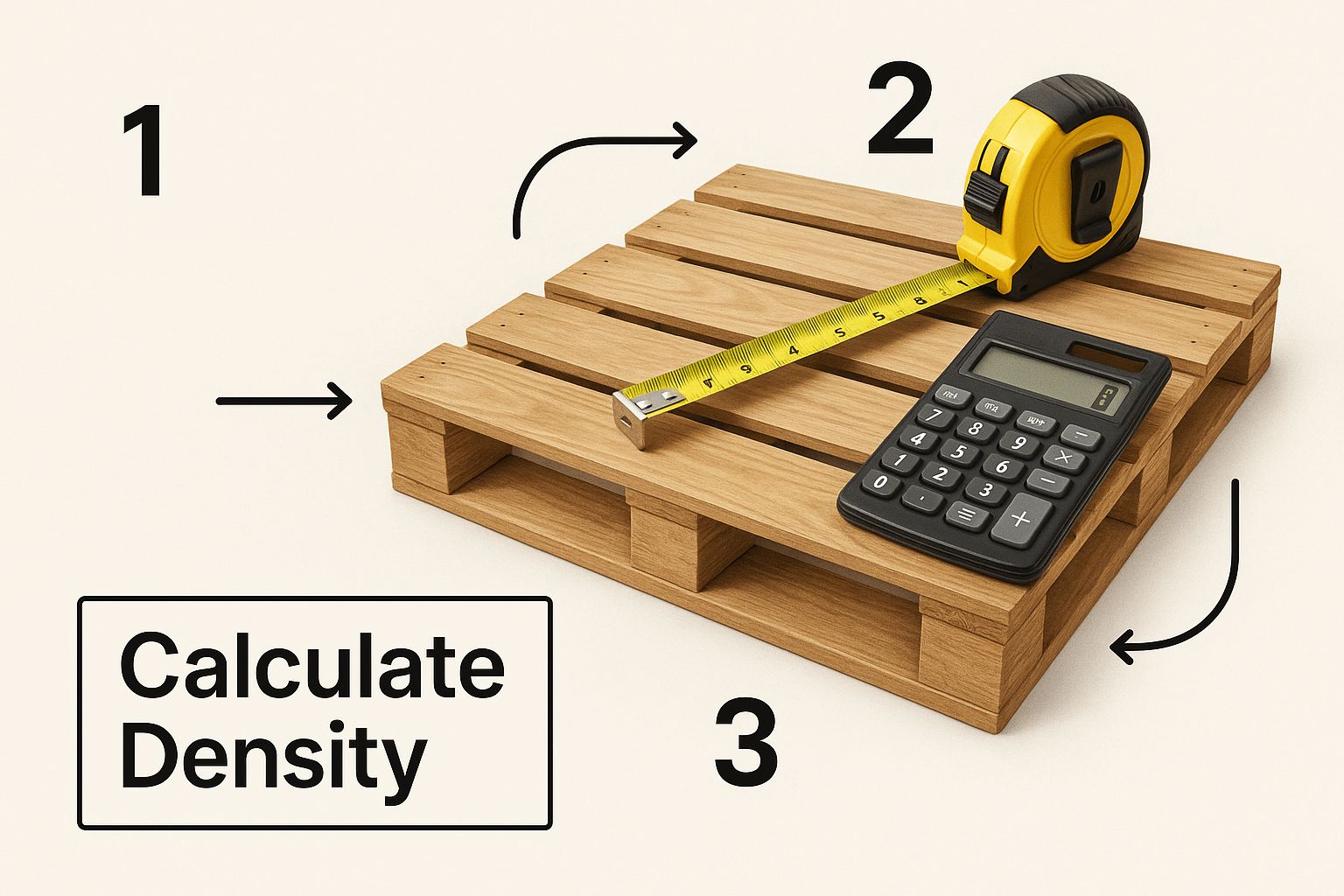Learn how to determine freight class with our guide. We break down density calculations, NMFC codes, and common mistakes to help you avoid fees.

Figuring out your freight class is really about sizing up how "shippable" your items are. It’s a system that looks at four main things—density, stowability, handling, and liability—to slot your cargo into one of 18 different classes. These range from Class 50 (the cheapest to ship) all the way up to Class 500 (the most expensive).
Ready to find the right class for your FTL or LTL freight?

Let's be honest—freight class can feel like a complicated puzzle. But getting it right is probably the single most important thing you can do to control your shipping costs and avoid nasty surprises.
Think of it as the language carriers use to price your shipment. With 18 classes to choose from, even a small miscalculation can lead to a big, unexpected bill.
When you master how to find your freight class, you're back in the driver's seat. You can stop those frustrating reweigh charges and billing adjustments that chip away at your profit margin. This guide will walk you through the practical steps to classify your freight with confidence, every single time.
Getting the freight class wrong isn't just a minor paperwork error; it's a direct hit to your budget. Carriers are constantly inspecting shipments, and if they find a mismatch, they'll issue a "reclassification." This doesn't just adjust the rate—it almost always comes with hefty administrative fees on top.
The National Motor Freight Traffic Association (NMFTA) created the National Motor Freight Classification (NMFC) system way back in 1936 to standardize things. Yet, even with decades of history, industry insiders estimate that a staggering 25% of freight shipments—that's one in four—get reclassified by carriers because of errors. Often, it's something as simple as a mistake in measuring the weight or dimensions. You can find more details on the NMFC system at onesilq.com.
When you classify your shipment correctly from the get-go, your pricing becomes predictable. The quote you receive will actually match your final invoice, which eliminates budget headaches and helps build trust with your carriers. This kind of accuracy is the bedrock of smart logistics management.
By taking a few extra minutes to verify your freight’s dimensions, weight, and characteristics, you transform shipping from a variable expense into a predictable one.
This simple act of diligence is crucial for understanding your total shipping costs. If you want to dig deeper into the numbers, check out our guide on how to calculate freight rates.
Ultimately, knowing how to determine freight class isn't just about playing by the rules. It's a strategic move that directly protects your bottom line and keeps your supply chain running smoothly without those costly, frustrating interruptions.
Before we get our hands dirty with the calculator, it’s crucial to understand why freight classes exist in the first place. Carriers aren’t just picking numbers at random; they're looking at your shipment through a lens of four "transportability" characteristics.
Getting a grip on these will give you a much better feel for why your freight gets the class it does and help you anticipate costs more accurately.
Density is, without a doubt, the biggest piece of the puzzle. In simple terms, it's the relationship between your shipment's weight and the space it takes up. Think of it like this: a pallet of lead weights is incredibly dense (and gets a low freight class), while a pallet of pillows is the opposite (and gets a high freight class).
Why does this matter so much? Because a carrier's most precious commodity is space on their truck. The more weight they can pack into a small footprint, the more money they make. That’s why a heavy, compact shipment costs less per pound to move than a light, bulky one that eats up valuable trailer real estate.
Not sure if your LTL or FTL shipment even needs a freight class? Let's figure it out.
Next up is stowability. This is all about how easily your freight can be loaded, arranged, and transported with other shipments. Carriers are masters of Tetris, trying to fit as much freight as possible into a trailer. Anything that disrupts that flow is a problem.
Carriers also look at handling, which is exactly what it sounds like: how easy or difficult is it to get your shipment on and off the truck? A standard pallet that a forklift or pallet jack can grab in seconds is simple.
But if your freight is extremely heavy, fragile, or has an awkward shape, it might require special equipment, more manpower, or just extra-careful attention.
Think about the difference between a pallet of durable steel pipes versus a delicate, one-of-a-kind glass sculpture. The pipes are a breeze to handle. The sculpture? That requires a whole different level of care, time, and effort, which naturally bumps up the freight class.
Last but not least is liability. This covers the risk the carrier takes on when they transport your goods. It’s a combination of things like the potential for theft, damage to your shipment, or even the chance that your shipment could damage other freight around it.
A pallet of high-end electronics carries a much higher liability than a pallet of gravel. If something happens to the electronics, the claim could be huge. The same goes for perishable food that could spoil or hazardous materials that could leak. The higher the risk for the carrier, the higher the freight class.
Ready to see how these factors add up for your shipment? Let's get you a price.
Alright, let's get down to the brass tacks: calculating your freight density. This isn't just about numbers; it's about getting your freight class right from the start to avoid those dreaded reclassification fees from the carrier. Think of this as the foundation for your entire shipping quote.
The process itself is pretty straightforward, but the details are everything. You'll need the length, width, and height of your shipment in inches, along with its total weight.
Before you even think about grabbing a tape measure, remember this one golden rule: always measure your shipment after it’s fully packaged and sitting on the pallet. Carriers don’t care what’s inside the box; they care about the total space the entire unit takes up in their truck. The pallet dimensions are absolutely part of the equation.
If you're unsure about pallet sizes and how they impact your shipment's footprint, our guide on standard shipping pallet sizes is a great resource.
Once your pallet is packed, stacked, and wrapped, carefully measure these three dimensions:
Getting these measurements right is crucial. Sometimes you might measure in feet, but the formula requires inches. If that's the case, a quick tool to convert feet to inches will save you a headache and ensure your math is spot-on.
Got your measurements? Great. Now for the easy part—a little bit of math. We’ll walk through the simple formula to find your shipment's Pounds per Cubic Foot (PCF).
Length (in) x Width (in) x Height (in) to get the total cubic inches.Total Shipment Weight (in pounds) by the Total Cubic Feet.That last number is your PCF, the key that unlocks your freight class.
This infographic gives you a great visual of what you'll need. As you can see, it's nothing complicated.

It really just comes down to a tape measure, a scale, and a calculator.
Let's Walk Through a Real-World Example:
Say you're shipping a standard pallet that measures 48"L x 40"W x 40"H. You pop it on the scale, and the total weight (pallet included!) comes out to 500 pounds.
- 48 x 40 x 40 = 76,800 cubic inches
- 76,800 / 1,728 = 44.44 cubic feet
- 500 lbs / 44.44 cubic feet = 11.25 PCF
With a density of 11.25 PCF, this shipment would most likely fall into Freight Class 92.5.
See? Once you have the measurements, it's just plugging them into the formula. This single number gives you incredible insight into what your shipping costs will look like.
Now that you have your PCF, you need to match it to a freight class. While the official NMFC guidelines are the final word, this chart is an excellent starting point and is accurate for most standard shipments.
Just find where your PCF falls in the left-hand column, and the number on the right is your estimated freight class. Simple as that.
While calculating density gets you in the right ballpark, it's the National Motor Freight Classification (NMFC) code that gets you the exact seat. Think of it as a specific ID number for whatever you're shipping. It tells the carrier everything they need to know beyond just how big and heavy it is. This is the final, crucial piece of the puzzle.
The NMFC system, which is managed by the National Motor Freight Traffic Association (NMFTA), is basically a massive catalog for every type of commodity you can imagine. This code boils down those four key factors we talked about—density, stowability, handling, and liability—into one standard number.
Relying only on density is a classic rookie mistake that can lead to some expensive corrections from the carrier. Why? Because some items, even with the same density, have completely different shipping needs.
Imagine you have two pallets that are the same size and weight. One is stacked with basic, mass-produced wooden nightstands. The other holds a collection of priceless, antique wooden chairs. Their densities might be nearly identical, but their handling needs and liability couldn't be more different.
The NMFC code is what accounts for this critical distinction. The antique chairs would get a specific code that reflects their high value and fragility, placing them in a different freight class than the standard furniture. Skipping this detail is a surefire way to get hit with a reclassification fee after the fact.
Think of an NMFC code as your product's shipping DNA. It communicates its unique traits to the carrier, ensuring your freight class—and your final bill—is dead-on accurate.
This is exactly why just giving a carrier the density isn't enough. The NMFC gives them the specific context they need to price your LTL shipment correctly and, just as importantly, handle it safely.
So, where do you actually find this all-important code? You've got a few solid options to track down the right number for your freight.
Taking a few minutes to find the correct NMFC code isn't just busywork; it's the step that protects you from surprise charges and makes sure your quote is accurate from the get-go.

After years in the logistics world, I've seen it all. Trust me, the costliest mistakes are almost always the simplest ones to prevent. If you want to avoid those frustrating surprise fees and keep your shipping budget in check, sidestepping these common pitfalls is the fastest way to do it.
Taking just a few extra minutes to get the details right will save you a world of headaches—and a lot of money—down the road.
The absolute number one mistake? Eyeballing it. Please, never guess your shipment's measurements or weight. A carrier’s high-tech laser scanner and calibrated scale don't have a margin of error, and even a small discrepancy can easily trigger a reclassification and a much bigger bill.
Here’s a pro tip: always measure and weigh your shipment after it’s been fully packaged, wrapped, and secured to the pallet. Those final, "all-in" numbers are the only ones the carrier cares about.
This is a classic rookie move. The pallet is part of the shipment, period. Its dimensions and weight absolutely have to be in your final calculation. Forgetting to add its weight (which is usually 30-70 pounds) or its height (typically around 5-6 inches) will completely skew your density calculation.
This simple oversight is honestly one of the most frequent reasons for reclassification fees. The carrier is moving the entire unit, so you have to measure the entire unit. Simple as that.
A small detail like forgetting the pallet's weight can be the difference between a Class 70 and a Class 85 shipment, resulting in an immediate and avoidable price increase.
Your commodity description on the Bill of Lading (BOL) needs to be crystal clear. Writing something generic like "Machine Parts" or "Building Supplies" is practically begging a carrier to inspect your freight. Vague descriptions create ambiguity, which makes them question everything from handling requirements to liability.
Be specific. Instead of just "Electronics," write "Pallet of Computer Monitors." This clarity tells the carrier exactly what they're dealing with and helps validate the NMFC code you’ve provided, dramatically reducing the chances of a dispute.
Finally, let's talk about "FAK" or Freight All Kinds agreements. This is a special type of contractual rate that lets a shipper move multiple products with different classes under a single, negotiated class. It sounds great, right?
But here’s the catch: it's not a free-for-all. An FAK is a specific deal negotiated between a shipper and a carrier. Unless you have an FAK explicitly written into your contract, you must classify each commodity on its own merits. Assuming an FAK applies when it doesn't is a guaranteed ticket to a corrected—and much higher—freight bill.
Even after you get the hang of freight classification, a few questions always seem to surface. We've been there. Let's tackle some of the most common ones so you can ship with total confidence and avoid those frustrating—and costly—mistakes.
This is a big one. If you accidentally (or intentionally) list the wrong freight class, you can bet the carrier will catch it. They regularly inspect and weigh shipments, and when they find a discrepancy, they'll reclassify it for you.
The problem? They'll reclassify it to the correct class—which is almost always a more expensive one—and send you an adjusted bill. This new bill won't just have the rate difference; it will also include some pretty hefty administrative fees for their trouble. These unexpected charges can throw a real wrench in your shipping budget.
The only way to consistently avoid this is to be meticulous with your measurements and commodity details right from the start. A little extra care upfront saves a lot of headaches later.
Yes, without a doubt. The freight class system works on an inverse scale. The lower the class number, the lower your shipping cost per pound will be.
It's easier to think about it with a couple of real-world examples:
Basically, a lower class number tells the carrier your shipment is less of a risk and requires less special handling, and the price reflects that.
Moving a shipment from a Class 100 down to a Class 92.5 might not sound like much, but those savings really add up over hundreds of shipments. Accuracy isn’t just about dodging fees; it’s about securing the best possible rate every single time.
If you're shipping LTL (Less-Than-Truckload), the answer is a hard yes. The NMFC code is absolutely essential for carriers to price your shipment correctly. It provides a level of detail that the freight class alone just can't offer.
Think of it this way: freight class is a general category based on transport characteristics like density. The NMFC code, on the other hand, identifies the exact commodity you're shipping. This is crucial because two items might have the same density but completely different handling requirements or liability concerns.
The NMFC number and the freight class work hand-in-hand to give the carrier a complete picture of your freight. For LTL carriers, this isn't optional—it's a requirement.
Still have questions? The team at FreightQuotesNow lives and breathes this stuff. We can help you find the right class and the best rate for your shipment in minutes.